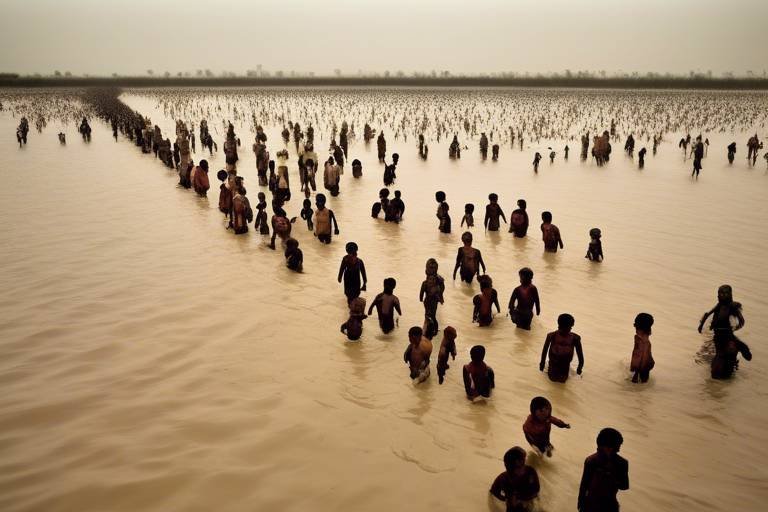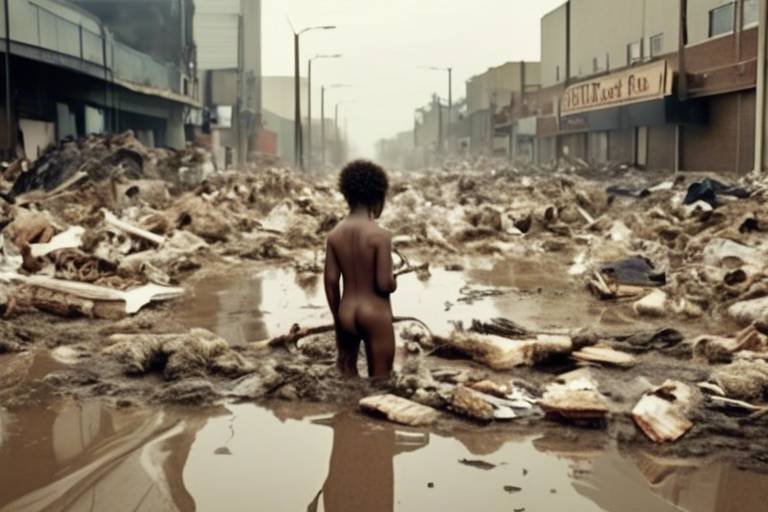Climate Change: Understanding the Impact on Human Migration
Climate change is not just a distant threat; it's a pressing reality that is reshaping our world in profound ways. As global temperatures rise, we are witnessing a dramatic shift in weather patterns, which in turn is influencing human behavior on an unprecedented scale. One of the most alarming consequences of climate change is its impact on migration. People are being forced to leave their homes, not just because of natural disasters, but due to gradual environmental changes that make their living conditions untenable. Understanding this intricate relationship between climate change and human migration is crucial, as it affects not only the displaced individuals but also the communities they leave behind and those they move to.
At its core, climate change is driven by a combination of human activities, such as burning fossil fuels and deforestation, leading to increased levels of greenhouse gases in the atmosphere. This results in a myriad of consequences, including rising sea levels, extreme weather events, and altered ecosystems. The scientific consensus is clear: climate change is real, and it poses a significant threat to global stability. As we delve into this topic, we will explore how these environmental factors are not just abstract concepts but tangible realities that compel people to migrate. The urgency of this issue cannot be overstated; it is a global crisis that requires immediate attention and action.
As we navigate through the complexities of climate-induced migration, it’s important to recognize that this phenomenon is not uniform. Different regions experience varying impacts based on their geographical and socio-economic contexts. For instance, coastal communities are grappling with the threat of rising sea levels, while those in arid regions face desertification and water scarcity. Each scenario presents unique challenges and necessitates tailored responses. In the following sections, we will unpack these dynamics, showcasing the stories of those affected and the broader implications for societies worldwide.
In summary, the relationship between climate change and human migration is intricate and multifaceted. It is a subject that demands our attention as we strive to understand the driving forces behind this phenomenon and the urgent need for effective policy responses. As we move forward, let’s keep in mind the human stories behind the statistics, acknowledging that behind every migration is a story of resilience, adaptation, and hope.
- What are the main causes of climate-induced migration?
Climate-induced migration is primarily caused by extreme weather events such as hurricanes, floods, and droughts, as well as long-term environmental changes like rising sea levels and desertification.
- How does climate change affect different regions differently?
Different regions face unique challenges based on their geography and socio-economic conditions. Coastal areas may be more affected by flooding, while arid regions may struggle with water scarcity.
- What can governments do to address climate-induced migration?
Governments can implement policies that promote sustainable migration practices, support affected communities, and foster international cooperation to manage migration flows effectively.

The Science of Climate Change
Understanding the fundamental principles of climate change is essential to grasp its effects on human migration. At its core, climate change refers to significant alterations in temperature, precipitation, and other atmospheric conditions over extended periods. These changes are primarily driven by human activities, particularly the burning of fossil fuels, deforestation, and industrial processes, which release greenhouse gases (GHGs) into the atmosphere. The most prevalent GHG is carbon dioxide (CO2), followed closely by methane (CH4) and nitrous oxide (N2O).
The scientific consensus on climate change is overwhelming. According to reports from the Intergovernmental Panel on Climate Change (IPCC), global temperatures have risen by approximately 1.1 degrees Celsius since the late 19th century, a change that has already begun to impact weather patterns, sea levels, and ecosystems worldwide. This warming is not just a number; it translates into more frequent and severe weather events, such as hurricanes, floods, and droughts, that disrupt lives and force people to migrate.
One might wonder, how does this all connect to human migration? Well, climate change acts as a threat multiplier, exacerbating existing vulnerabilities in communities. For instance, areas that are already struggling with poverty, political instability, or inadequate infrastructure are often the hardest hit by climate-related disasters. As these regions become increasingly uninhabitable, people are left with little choice but to seek refuge elsewhere. This phenomenon is not just limited to sudden disasters; gradual changes, such as rising sea levels and prolonged droughts, can also lead to slow but steady displacement.
To illustrate the scientific aspects of climate change and its impact on migration, consider the following table:
| Climate Change Factor | Impact on Migration |
|---|---|
| Rising Temperatures | Increased heatwaves and health risks, forcing people to relocate. |
| Extreme Weather Events | Natural disasters lead to immediate displacement and destruction of homes. |
| Sea Level Rise | Coastal communities face flooding, prompting migration inland. |
| Desertification | Loss of arable land leads to food insecurity and forced migration. |
In summary, the science of climate change reveals a complex interplay between human actions and environmental consequences. As we continue to witness the effects of climate change, it becomes increasingly clear that understanding its science is crucial for addressing the challenges of human migration. The urgency of the situation calls for immediate action, not only to mitigate climate change but also to support those who are already affected by its devastating impacts.
- What is climate change? - Climate change refers to significant changes in global temperatures and weather patterns over time, primarily caused by human activities.
- How does climate change affect migration? - Climate change can lead to extreme weather events and long-term environmental changes, forcing people to leave their homes.
- What can be done to mitigate climate change? - Reducing greenhouse gas emissions, transitioning to renewable energy sources, and implementing sustainable practices are key steps.

Climate-Induced Displacement
The phenomenon of is becoming increasingly prevalent as our planet faces the harsh realities of climate change. As environmental conditions deteriorate, communities are finding themselves in a position where staying put is no longer an option. Imagine waking up one day to find that your home is no longer safe, whether due to rising waters or the relentless advance of desertification. This scenario is not just a figment of imagination; it's a reality for millions around the globe.
Extreme weather events, such as hurricanes and floods, are becoming more frequent and severe, leading to sudden and often catastrophic displacement. For instance, in 2020, Hurricane Laura wreaked havoc in Louisiana, forcing thousands to evacuate their homes in a matter of hours. The aftermath saw entire communities uprooted, with many never returning. Such events illustrate how natural disasters can act as a catalyst for migration, pushing people to seek safety and stability elsewhere.
But it’s not just the sudden disasters that cause displacement. Long-term environmental changes are equally significant. Rising sea levels threaten coastal communities, while persistent droughts can render agricultural land barren, stripping families of their livelihoods. As these gradual changes unfold, they create a slow-burning crisis where people are compelled to leave their homes in search of better living conditions. For example, the Sahel region in Africa is experiencing increasing desertification, which is driving rural populations toward urban areas or even across borders in search of arable land and water.
The implications of climate-induced displacement are profound and multifaceted. Not only does it disrupt the lives of those who are forced to migrate, but it also places immense pressure on the regions that receive these displaced populations. Host communities often struggle to accommodate the influx of newcomers, leading to potential conflicts over resources, housing, and jobs. The strain on local infrastructure can lead to a cascading effect, where both migrants and locals face heightened vulnerabilities.
Moreover, the psychological impact of displacement cannot be overlooked. Leaving one’s home is not just a physical act; it carries emotional weight. Families are often torn apart, traditions are disrupted, and cultural identities can be lost. The resilience of affected communities is remarkable, but the scars of displacement can last for generations. In many cases, individuals find themselves in a state of limbo, unsure of their future and longing for the familiarity of their past.
As we navigate through this complex landscape of climate-induced displacement, it’s essential to recognize the need for comprehensive strategies that address both the immediate and long-term challenges. This includes developing policies that not only assist those who are displaced but also bolster the resilience of communities at risk. By fostering a collaborative approach that involves governments, NGOs, and local populations, we can work towards solutions that mitigate the impact of climate change and support sustainable migration practices.
- What is climate-induced displacement?
Climate-induced displacement refers to the forced movement of people due to environmental changes caused by climate change, such as extreme weather events and long-term changes like rising sea levels. - How does climate change affect migration patterns?
Climate change leads to environmental degradation that can make areas uninhabitable, prompting people to migrate to safer locations in search of better living conditions. - What are some examples of climate-induced displacement?
Examples include communities displaced by hurricanes, floods, droughts, and rising sea levels, such as those affected by Hurricane Katrina or the ongoing crisis in the Sahel region. - What can be done to support displaced populations?
Comprehensive policies that provide immediate assistance to displaced individuals, as well as long-term strategies to build resilience in vulnerable communities, are essential.

Extreme Weather Events
When we think about climate change, one of the most alarming aspects is the increase in . These events are not just occasional occurrences; they are becoming more frequent and intense, reshaping the landscape of human migration. Imagine a community that has thrived for generations suddenly facing the wrath of a hurricane or the relentless grip of a drought. These scenarios are becoming more common, forcing people to leave their homes in search of safety and stability.
Take hurricanes, for example. With warmer ocean temperatures, these storms are gaining strength and causing catastrophic damage. In 2017, Hurricane Harvey dumped over 50 inches of rain on Houston, Texas, leading to unprecedented flooding. Thousands of families were displaced, their homes destroyed, and their lives turned upside down. This isn't just a one-off incident; similar patterns can be seen with other hurricanes, such as Katrina in 2005 and Maria in 2017. Each event leaves a trail of devastation and a growing number of climate refugees.
But it's not just hurricanes we need to worry about. Floods, wildfires, and heatwaves are also on the rise. For instance, wildfires in California have become a yearly nightmare, fueled by hotter temperatures and prolonged droughts. The fires not only destroy homes but also create a toxic environment that makes it impossible for residents to stay. As these disasters become more common, the question arises: how many more people will be forced to leave their homes?
To illustrate the breadth of this issue, consider the following table that highlights some major extreme weather events and their impacts on migration:
| Event | Year | Location | Impact on Migration |
|---|---|---|---|
| Hurricane Harvey | 2017 | Houston, Texas | Over 30,000 people displaced |
| Hurricane Katrina | 2005 | New Orleans, Louisiana | Over 1 million people evacuated |
| California Wildfires | 2020 | California | Thousands evacuated, homes destroyed |
| Typhoon Haiyan | 2013 | Philippines | Over 4 million displaced |
These examples illustrate the harsh reality faced by communities around the world. Each disaster not only displaces individuals but also disrupts local economies, education, and healthcare systems. The ripple effects are felt not just by those who leave but also by the communities that receive them. As cities and towns grapple with an influx of newcomers, resources become strained, leading to tensions and challenges in integration.
In conclusion, extreme weather events driven by climate change are a significant catalyst for human migration. The impacts are profound and multifaceted, affecting individuals, families, and entire communities. As we continue to witness these changes, it's crucial to understand the urgency of the situation and the need for proactive measures to support those affected.
- What are extreme weather events? Extreme weather events refer to severe and unusual weather patterns, including hurricanes, floods, droughts, and wildfires, often intensified by climate change.
- How does climate change affect migration? Climate change leads to extreme weather events and long-term environmental changes that can force people to leave their homes in search of safety and stability.
- What can be done to support climate refugees? Governments and organizations can implement policies that provide aid, promote sustainable migration practices, and improve local adaptation strategies.

Case Studies of Displacement
When we think about climate change, it’s easy to get lost in the science and statistics. However, the real stories lie in the lives of people who have been uprooted from their homes due to environmental disasters. Let’s dive into some compelling case studies that highlight the stark reality of climate-induced displacement.
One of the most striking examples is the situation in Bangladesh. This country is often cited as one of the most vulnerable to climate change, primarily due to its low-lying geography. Rising sea levels have led to the salinization of freshwater resources, making it increasingly difficult for communities to sustain their livelihoods. In 2020 alone, approximately 1.5 million people were displaced due to flooding and erosion. This mass movement not only disrupts lives but also strains resources in urban areas where many migrants seek refuge.
Across the globe, we have the case of the Syrian Civil War, which, while primarily political, has been exacerbated by climate factors. A severe drought from 2006 to 2011 devastated agricultural production, forcing farmers to abandon their lands and migrate to urban centers. This influx of people into cities like Damascus contributed to social unrest and ultimately played a role in the outbreak of the civil war. The interplay between climate change and conflict illustrates how environmental stressors can lead to significant human displacement.
Another poignant example comes from the Pacific Islands, particularly Tuvalu and Kiribati. These nations face the existential threat of rising sea levels, which could render them uninhabitable in the coming decades. The government of Tuvalu is already preparing for potential migration by negotiating with countries like New Zealand to accept climate refugees. This proactive approach highlights the need for international cooperation in addressing the challenges posed by climate-induced migration.
In the Americas, we see the impact of climate change on communities in Central America, particularly in countries like Honduras and Guatemala. Here, increasing temperatures and erratic rainfall patterns have led to crop failures, pushing farmers to migrate northward in search of better opportunities. In 2019, it was estimated that around 300,000 people from this region migrated to the United States due to climate-related factors. This migration not only affects the migrants but also has significant implications for the countries they leave behind and those they move to.
These case studies serve as a stark reminder of the human cost of climate change. They reveal the intricate connections between environmental degradation, migration, and social stability. As we continue to witness these patterns, it becomes increasingly clear that addressing climate change is not just an environmental issue; it’s a humanitarian one.
To further illustrate the impact of climate-induced displacement, the following table summarizes the key aspects of each case study:
| Location | Displacement Trigger | Estimated Displaced Population | Implications |
|---|---|---|---|
| Bangladesh | Rising sea levels and flooding | 1.5 million (2020) | Strain on urban resources |
| Syria | Drought leading to agricultural collapse | Hundreds of thousands | Contributed to civil unrest |
| Pacific Islands | Rising sea levels | Potentially entire populations | Need for international migration agreements |
| Central America | Crops failures due to climate change | 300,000 (2019) | Impact on U.S. immigration policies |
These examples illustrate that climate change is not just a distant threat; it’s a reality that is reshaping communities and lives today. Understanding these stories is crucial for fostering empathy and motivating action to address the root causes of climate-induced migration.
- What is climate-induced migration?
Climate-induced migration refers to the movement of people forced to leave their homes due to sudden or gradual changes in their environment caused by climate change.
- How does climate change affect migration patterns?
Climate change leads to extreme weather events, rising sea levels, and long-term environmental changes, all of which can displace communities and force them to seek new homes.
- What can be done to support climate migrants?
Policies promoting international cooperation, local adaptation strategies, and sustainable migration practices are essential to support those affected by climate change.

Long-Term Environmental Changes
Long-term environmental changes are like the slow, creeping tide that eventually washes away the shore. Unlike sudden natural disasters, these gradual shifts often go unnoticed until they reach a critical point, forcing communities to confront the reality of their changing world. One of the most significant long-term changes is rising sea levels, which can inundate coastal areas, displacing entire communities and erasing livelihoods. Imagine waking up one day to find that your home is now part of the ocean—this is the stark reality for many living in vulnerable regions.
Another critical factor is desertification, where once-fertile land transforms into arid wasteland, making it increasingly difficult for communities to sustain agriculture. This phenomenon can lead to food shortages, economic instability, and ultimately, migration. For instance, the Sahel region in Africa has witnessed significant desertification, pushing people to migrate southward in search of arable land and better living conditions.
Additionally, changing weather patterns can disrupt traditional agricultural practices. Farmers who have relied on predictable seasons may find themselves struggling as rainfall becomes erratic or temperatures soar. This unpredictability not only threatens food security but also forces families to seek more stable environments. As these long-term changes continue to unfold, the pressure on communities to migrate increases, creating a ripple effect that impacts urban areas and neighboring countries.
To illustrate the impact of these long-term environmental changes, consider the following table that summarizes some key factors:
| Environmental Change | Impact on Migration | Examples |
|---|---|---|
| Rising Sea Levels | Inundation of coastal areas | Maldives, New Orleans |
| Desertification | Loss of arable land | Sahel Region, Central Asia |
| Changing Weather Patterns | Unpredictable seasons affecting agriculture | Sub-Saharan Africa, Southern Europe |
The interplay between these long-term environmental changes and human migration is complex and multifaceted. As communities grapple with the implications of their shifting environments, the need for adaptive strategies becomes increasingly clear. Local governments and organizations must prioritize sustainable practices and resilience-building initiatives to help communities not only survive but thrive in the face of these challenges. After all, migration should not merely be seen as a last resort but as a potential pathway to new opportunities and growth.
- What are the main causes of long-term environmental changes?
Long-term environmental changes are primarily driven by factors such as climate change, deforestation, urbanization, and industrialization. - How do these changes affect human migration?
As environmental conditions deteriorate, people are often forced to leave their homes in search of better living conditions, leading to significant population movements. - What can communities do to adapt to these changes?
Communities can implement local adaptation strategies such as sustainable agriculture practices, water conservation, and infrastructure improvements to mitigate the impacts of environmental changes.

Socioeconomic Implications
The impact of climate-induced migration extends far beyond the immediate displacement of individuals and families; it reverberates through entire communities and economies. When people are forced to leave their homes due to climate change—whether from a devastating hurricane, relentless drought, or rising sea levels—they carry with them not just their belongings but also their hopes, dreams, and skills. However, this migration can create a cascade of socioeconomic challenges that affect both the migrants and the communities they leave behind or move to.
Firstly, let's consider the **migrants** themselves. Many of them find themselves in precarious situations, often arriving in new locations with limited resources, no social networks, and uncertain legal status. This can lead to a cycle of poverty as they struggle to find employment and housing. Migrants may also face discrimination and social exclusion in their new communities, which can further hinder their ability to integrate and thrive. For instance, they might take up low-paying jobs in sectors that are often overlooked, such as agriculture or construction, which can perpetuate economic instability.
On the flip side, the **communities that receive migrants** also experience significant changes. While an influx of new residents can stimulate local economies by providing labor and increasing demand for goods and services, it can also strain existing resources. Schools, healthcare systems, and housing markets may become overwhelmed, leading to rising tensions between newcomers and long-time residents. For example, in urban areas experiencing rapid migration, housing prices may soar, pushing low-income families out of their neighborhoods and creating a ripple effect of displacement.
| Impacts on Migrants | Impacts on Host Communities |
|---|---|
|
|
Moreover, the **long-term socioeconomic implications** can be profound. As climate change continues to reshape our planet, we may witness shifts in global labor markets, with certain regions becoming uninhabitable and others potentially thriving due to an influx of people seeking refuge. This could lead to a reconfiguration of economic power dynamics, where traditionally stable regions face instability due to climate pressures, while others may experience growth and opportunity. It's a complex web of cause and effect that requires careful consideration and proactive planning.
In conclusion, addressing the socioeconomic implications of climate-induced migration is not just a humanitarian concern; it's an economic imperative. Governments, NGOs, and local communities must work together to create inclusive policies that support both migrants and host communities. By fostering understanding and cooperation, we can mitigate the negative impacts of migration while harnessing the potential benefits that diverse populations can bring to their new homes.
Q: What are the main causes of climate-induced migration?
A: Climate-induced migration is primarily driven by extreme weather events, such as hurricanes and floods, as well as long-term changes like rising sea levels and desertification, which make areas uninhabitable.
Q: How does climate change affect the economy of host communities?
A: While an influx of migrants can stimulate local economies, it can also strain resources, leading to challenges in housing, education, and healthcare, which may create tension between newcomers and long-time residents.
Q: What can be done to support climate migrants?
A: Governments and organizations can implement inclusive policies, provide legal support, and develop community programs that promote integration and economic opportunities for climate migrants.

Policy Responses to Migration
As the impacts of climate change become increasingly evident, the need for effective policy responses to migration has never been more critical. Governments and organizations around the globe are grappling with the challenges posed by climate-induced displacement. The reality is that when communities are forced to leave their homes due to environmental factors, it creates a ripple effect that can lead to social tensions, economic strain, and humanitarian crises. So, what can be done to address these challenges?
First and foremost, it’s essential to understand that there is no one-size-fits-all solution. Each region affected by climate change has its unique set of circumstances that require tailored approaches. For instance, coastal areas facing rising sea levels may need different strategies compared to arid regions experiencing severe drought. This is where collaboration and flexibility in policy-making come into play.
In many cases, international cooperation is vital. Countries must work together to create frameworks that allow for the safe movement of people displaced by climate-related disasters. This includes establishing legal protections for climate migrants and ensuring that their rights are upheld. For example, the Global Compact for Safe, Orderly and Regular Migration emphasizes the importance of international solidarity and the need to address the drivers of migration, including environmental degradation.
Moreover, local adaptation strategies can play a significant role in mitigating the effects of climate change on migration. Communities can be empowered to develop their own initiatives that not only address immediate challenges but also build resilience for the future. For instance, some regions have implemented sustainable agricultural practices that help farmers adapt to changing weather patterns, reducing the need to migrate in search of better conditions.
To illustrate the various policy responses, consider the following table that outlines some effective strategies being adopted worldwide:
| Policy Response | Description | Examples |
|---|---|---|
| Legal Protections | Establishing frameworks to protect the rights of climate migrants. | Global Compact for Migration |
| International Cooperation | Collaborative efforts among nations to manage climate-induced migration. | Regional agreements in the Pacific Islands |
| Local Adaptation Strategies | Community-driven initiatives to enhance resilience and reduce migration pressures. | Sustainable farming practices in Sub-Saharan Africa |
In addition to these strategies, it is crucial to foster awareness and education about climate change and its impacts on migration. By informing communities about the potential risks and available resources, we can empower them to make informed decisions about their future. This knowledge can be a lifeline for individuals contemplating migration as a last resort.
Ultimately, addressing climate-induced migration requires a multifaceted approach that combines local initiatives with international cooperation. As we navigate this complex landscape, it’s essential to remain adaptable and responsive to the changing needs of affected populations. After all, the goal is not just to manage migration but to create sustainable solutions that allow communities to thrive, regardless of the environmental challenges they face.
- What is climate-induced migration? Climate-induced migration refers to the movement of people caused by changes in the environment, such as extreme weather events or long-term shifts like rising sea levels.
- How does climate change affect migration patterns? Climate change can lead to natural disasters that displace communities, as well as gradual changes that make areas uninhabitable, forcing people to relocate.
- What can governments do to support climate migrants? Governments can create legal protections, foster international cooperation, and support local adaptation strategies to help affected populations.

International Cooperation
When it comes to tackling the colossal challenge of climate-induced migration, isn’t just a nice-to-have; it’s a necessity. Think of it as a global puzzle where every piece – from nations to communities – must fit together to create a comprehensive picture. As climate change knows no borders, neither should our responses to it. Countries around the world are beginning to realize that by working together, they can share resources, knowledge, and strategies to effectively manage the impacts of climate change on migration.
One of the most significant frameworks for international cooperation is the Paris Agreement, which aims to limit global warming and its associated effects. This agreement encourages nations to set their own targets for reducing greenhouse gas emissions, but it also emphasizes the importance of supporting vulnerable countries that are most affected by climate change. By pooling their resources and expertise, countries can create initiatives that not only address the root causes of climate change but also provide support for those who are displaced.
Moreover, organizations such as the United Nations High Commissioner for Refugees (UNHCR) and the International Organization for Migration (IOM) play pivotal roles in facilitating international dialogue and collaboration. These organizations work tirelessly to develop frameworks that help governments create policies addressing the needs of climate migrants. For instance, they advocate for the inclusion of climate change in national migration policies and encourage countries to adopt a whole-of-society approach, which involves multiple stakeholders, including local governments, civil society, and the private sector.
However, the road to effective international cooperation is fraught with challenges. Countries often have differing priorities, and some may be reluctant to accept climate migrants due to economic concerns or political climates. To overcome these hurdles, it’s vital for nations to engage in dialogue and build trust. This can be achieved through:
- Joint Research Initiatives: Collaborating on research can help countries understand the patterns and implications of climate migration.
- Shared Funding Mechanisms: Establishing funds to support climate adaptation and migration management can alleviate financial burdens on individual nations.
- Capacity Building: Training programs can empower local governments and organizations to better handle the influx of migrants and implement effective policies.
Ultimately, the success of international cooperation hinges on recognizing that climate change is not just an environmental issue; it’s a humanitarian one. By fostering a spirit of solidarity and shared responsibility, countries can create a more resilient global community capable of weathering the storms of climate change together. As we move forward, let’s not forget that every action counts, and together, we can make a significant difference in the lives of those affected by climate-induced migration.
- What is climate-induced migration? Climate-induced migration refers to the movement of people forced to leave their homes due to sudden or gradual changes in their environment, such as extreme weather events or long-term climate changes.
- How does international cooperation help with climate migration? International cooperation facilitates shared resources, knowledge, and strategies among countries to effectively manage and support climate migrants.
- What role do organizations like the UN play in climate migration? Organizations like the UNHCR and IOM help create frameworks for policy development and facilitate dialogue among nations to address the needs of climate migrants.
- What challenges exist in international cooperation for climate migration? Differing national priorities, reluctance to accept migrants, and financial constraints are some of the challenges that can hinder effective international cooperation.

Local Adaptation Strategies
As climate change continues to reshape our world, the need for effective has never been more critical. Communities around the globe are stepping up, finding innovative ways to cope with the challenges posed by rising temperatures, unpredictable weather patterns, and environmental degradation. But what does this really mean? Well, think of it like preparing for a storm: you wouldn’t just wait for the rain to start pouring; you’d gather your supplies, reinforce your home, and maybe even plan an escape route. Similarly, local adaptation strategies are about being proactive rather than reactive.
One of the most effective approaches communities are adopting is enhancing their infrastructure resilience. This involves upgrading roads, bridges, and public transport systems to withstand extreme weather events. For example, cities like New Orleans have invested heavily in flood defenses and improved drainage systems following the devastation of Hurricane Katrina. These upgrades not only protect lives and property but also ensure that communities can bounce back more quickly after disasters.
Moreover, community engagement plays a vital role in developing these strategies. When locals are involved in the decision-making process, they can share their unique insights and experiences, leading to more tailored and effective solutions. For instance, in coastal areas, communities might establish mangrove restoration projects to combat erosion and provide natural barriers against storm surges. This grassroots approach not only empowers residents but also fosters a sense of ownership and responsibility towards their environment.
Another key aspect is the integration of sustainable agricultural practices. As climate change alters weather patterns, farmers are adapting by implementing techniques that enhance soil health and conserve water. Practices such as crop rotation, agroforestry, and the use of drought-resistant crop varieties are becoming more common. These methods not only help secure food sources but also reduce the pressure on communities to migrate in search of better agricultural conditions.
In addition, education and awareness are crucial. Communities that are informed about climate risks and adaptation strategies are better equipped to respond effectively. Workshops, community meetings, and educational programs can empower residents to take action, whether it's through personal preparedness or collective initiatives. This proactive approach ensures that when the next environmental challenge arises, communities won't just survive—they'll thrive.
Finally, it's essential to create partnerships with local governments and NGOs. These collaborations can provide the necessary resources, funding, and expertise to implement adaptation strategies successfully. By pooling resources and knowledge, communities can tackle the multifaceted challenges of climate change more effectively. In many cases, local governments can also play a pivotal role in facilitating these partnerships, ensuring that adaptation efforts are not only sustainable but also equitable.
In summary, local adaptation strategies are not just about survival; they are about resilience, empowerment, and sustainability. By investing in infrastructure, engaging communities, promoting sustainable practices, educating residents, and fostering partnerships, we can create a future where communities are not merely reacting to climate change but actively shaping their destinies. The road ahead may be challenging, but with determination and collaboration, we can navigate these turbulent waters together.
- What are local adaptation strategies? Local adaptation strategies are proactive measures taken by communities to adjust to the impacts of climate change, ensuring resilience and sustainability.
- Why is community engagement important in adaptation strategies? Community engagement ensures that the solutions are tailored to the unique needs of the residents, fostering ownership and responsibility towards local environmental issues.
- How can sustainable agricultural practices help in adaptation? Sustainable agricultural practices enhance soil health, conserve water, and secure food sources, reducing the need for migration due to agricultural challenges.
- What role do partnerships play in local adaptation? Partnerships with local governments and NGOs provide resources, funding, and expertise, enabling communities to implement effective adaptation strategies.
Frequently Asked Questions
- What is climate change?
Climate change refers to significant and lasting changes in the Earth's climate. It's primarily driven by human activities, especially the burning of fossil fuels, which increases greenhouse gas emissions. These gases trap heat in the atmosphere, leading to global warming and various environmental shifts.
- How does climate change affect human migration?
Climate change can force people to relocate due to extreme weather events like hurricanes and floods, as well as long-term changes such as rising sea levels and desertification. As their environments become uninhabitable, communities are left with no choice but to migrate, leading to significant population shifts.
- What are some examples of climate-induced displacement?
There are numerous examples, including the displacement of communities in Bangladesh due to rising sea levels and the migration of people from the Sahel region in Africa facing severe droughts. These situations highlight the urgent need for effective responses to support affected populations.
- What socioeconomic impacts arise from climate-induced migration?
Climate-induced migration can strain resources in host communities, leading to competition for jobs, housing, and services. Conversely, it can also result in opportunities for cultural exchange and economic growth, depending on how well the migration is managed.
- How are governments responding to climate-induced migration?
Governments are developing policies that address the challenges of climate migration, including creating frameworks for international cooperation and local adaptation strategies. These policies aim to support migrants while ensuring that host communities can accommodate newcomers sustainably.
- Why is international cooperation important in managing climate migration?
International cooperation is crucial because climate change knows no borders. Countries must work together to share resources, knowledge, and best practices to effectively manage migration and support displaced populations. This collaborative approach helps to build resilience and promote sustainable solutions.
- What local adaptation strategies can communities implement?
Communities can adopt various local adaptation strategies, such as improving infrastructure to withstand extreme weather, developing sustainable agricultural practices, and creating awareness programs about climate risks. These initiatives empower communities to mitigate the impacts of climate change and reduce the need for migration.



















